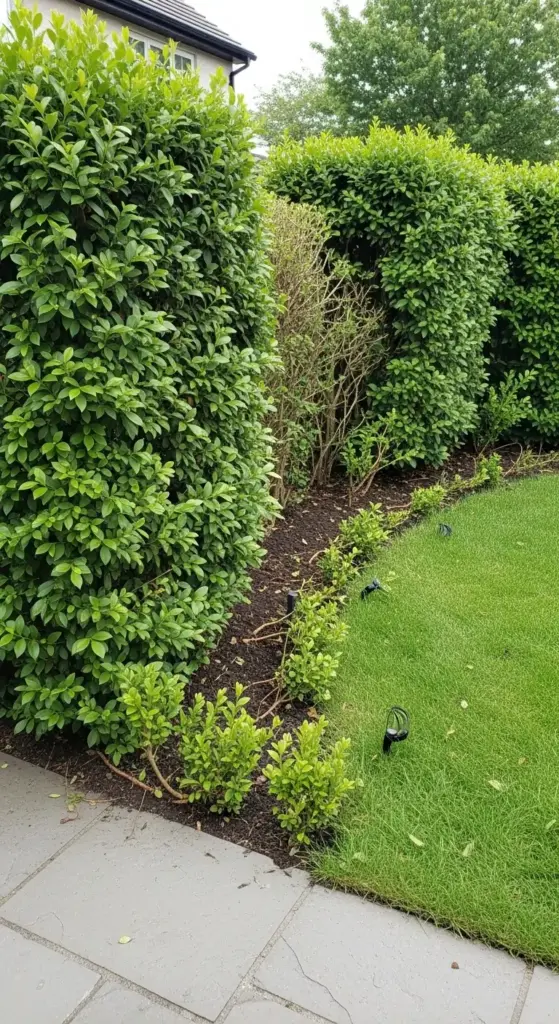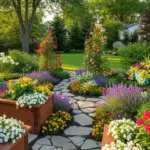5. Living Edging with Structured Root Barriers

My boxwood hedge looked absolutely perfect for exactly six months. Then it started creeping into my lawn, sending runners under my walkway, and generally taking over like some kind of green monster.
That’s when I discovered the game-changing world of structured root barriers and proper living edging techniques. Now my hedges stay exactly where I want them while looking better than ever.
Professional Plant Selection for Edging Success
Plant selection for edging isn’t just about what looks pretty – it’s about growth habits, root systems, and long-term maintenance requirements. I learned this after planting fast-growing privet that needed trimming every three weeks.
Slow-growing, compact varieties are your best friends. Buxus microphylla (Japanese boxwood) grows only 2-4 inches per year and maintains tight form naturally.
Dwarf mondo grass creates stunning linear edges with zero pruning required. It spreads slowly and stays exactly 4-6 inches tall forever.
For colorful options, Heuchera (coral bells) provides year-round interest without aggressive spreading. I space them 12 inches apart for full coverage in two seasons.
Climate zone matching is non-negotiable. I once lost 50 feet of expensive lavender edging because I ignored my zone 5 reality and planted zone 7 varieties.
Root Barrier Installation That Actually Works
Root barrier systems changed everything about my living edges. No more grass invasion, no more hedge creep, no more constant battle for territory.
I install barriers 18-24 inches deep minimum. Shallow barriers are useless – roots just dive under and pop up on the other side.
HDPE plastic barriers work best for most applications. They’re flexible enough to follow curves but rigid enough to stop aggressive root systems.
My installation secret? Dig the trench 2 inches wider than the barrier. This gives you room to backfill properly without creating air pockets that roots can exploit.
Overlap joints by 6 inches minimum and seal with landscape adhesive. One unsealed joint ruins the entire system.
Maintenance Schedules for Healthy Growth
Living edge maintenance follows a strict schedule in my garden. Spring inspection, summer monitoring, fall preparation, winter protection.
April is root barrier check time. I walk the entire edge looking for any signs of root escape or barrier damage from frost heaving.
Monthly trimming during growing season keeps everything tight and uniform. I never let growth get more than 2 inches beyond my desired shape.
Summer watering happens every other day during dry spells. Stressed plants break form and become susceptible to disease and pest problems.
Seasonal Pruning and Shaping Methods
Proper pruning technique makes the difference between professional-looking edges and amateur hack jobs. I learned this after butchering my first boxwood hedge with hedge shears.
Hand pruning with bypass pruners creates natural, healthy cuts that heal quickly. Hedge shears crush stems and create entry points for disease.
Spring shaping happens just before new growth starts. This gives plants the entire growing season to fill in and look perfect by fall.
I follow the 1/3 rule religiously – never remove more than one-third of the plant’s growth in a single pruning session. More than that shocks the plant and ruins the shape.
Root Barrier Depth Strategies
Barrier depth calculations depend entirely on your plant choices. Shallow-rooted plants like hostas need 12-inch barriers, while aggressive spreaders need 24-inch minimum.
Bamboo requires 30-inch barriers or it will laugh at your efforts. I learned this when my “contained” bamboo planting took over half my yard.
Sloped installation prevents water pooling along the barrier. I angle the top edge slightly away from the planting area.
Clay soils need deeper barriers because roots follow the path of least resistance along the clay-barrier interface.
Irrigation Integration Secrets
Drip irrigation integration with living edges is pure genius. I run 1/4-inch tubing along the plant side of the root barrier for targeted watering.
Emitter spacing depends on plant maturity. New plantings need emitters every 12 inches; established hedges can handle 18-24 inch spacing.
Pressure-compensating emitters ensure uniform water distribution along the entire edge. Regular emitters create dry spots at the end of long runs.
I always install a moisture sensor in the root zone. Overwatering kills more living edges than drought ever will.
My Biggest Living Edge Disaster
I once planted 80 feet of Miscanthus grass without any root barriers. Within two years, it had invaded three neighboring properties and cost me $800 in removal fees.
That expensive lesson taught me to research growth habits thoroughly and always overengineer containment systems.
Aggressive spreaders require aggressive containment – there’s no middle ground with invasive plants.
Plant Spacing for Professional Results
Proper spacing creates full coverage without overcrowding. I space small shrubs at 75% of their mature width – closer looks rushed, wider leaves gaps.
For hedge-style edges, I plant slightly closer than recommended. This creates faster fill-in and allows for natural plant loss without visible gaps.
Staggered planting patterns look more natural than straight lines. I offset every other plant by 6 inches for organic, flowing edges.
Cost and Time Investment Reality
Living edge installation costs $12-25 per linear foot including plants, barriers, and irrigation. The ongoing maintenance time is significant – plan on 2-3 hours monthly during growing season.
Plant establishment takes 2-3 seasons for full effect. Patience is required, but the results are worth the wait.
Professional installation runs $35-60 per linear foot, but includes plant guarantees and establishment care.
Ready to discover the industrial-strength edging technique that creates stunning stone-filled barriers using professional wire mesh systems? Click “next” to learn about gabion stone edging that combines engineering precision with natural beauty!









GIPHY App Key not set. Please check settings